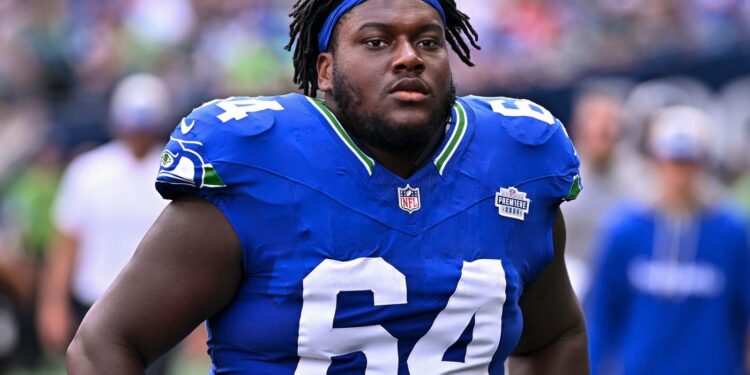Trouble may be building quietly for Christian Haynes, Seattle Seahawks’ offensive lineman, as his presence was absent during the main practice drills on Friday. Haynes, who is in his second year and played college football at Connecticut, was not seen taking part in reps while others went through their routines on the field.
While there may be a reason behind his absence, no one from the coaching staff has explained it yet. Charles Cross, the team’s left tackle, also missed practice, but in his case, the situation is clear: he had surgery for a dislocated finger and will be out for a few weeks.

So far, there has been nothing pointing to an injury for Haynes. The situation appears to be more about his place in the lineup. Right now, it seems like he has been passed up once more by Sataoa Laumea, who also joined the team from the 2024 draft and filled the right guard position last season.
Many people have begun to ask whether it is too early to judge Christian Haynes negatively. Expectations were high for his second year, especially with a fresh coaching team and a system that places more importance on running plays. But the early signs from camp do not reflect what many had hoped for.
Competition Grows While Haynes Loses Practice Time
The three players who rotated at right guard last season, Haynes, Laumea, and Anthony Bradford, were expected to compete once again for the spot. None of them were standout performers last year. Even so, general manager John Schneider did not bring in many new faces apart from a few Day 3 draft picks, showing some trust in the current group.
As camp opened, things looked like a direct battle between Bradford and Haynes. But by the end of the first week, another name joined the mix: Jalen Sundell, who many expected to serve as backup center, began getting reps at right guard.
It now appears that Laumea is also being given more chances during practices. What’s clear is that Bradford has not lost time to these players; it is Haynes who is missing out.
Questions Rise Over Haynes’ Ability and Background
Coming out of college, Haynes received plenty of praise from scouts who believed he had the tools to succeed. They pointed out his smart approach, proper footwork, and understanding of play formations. But they also knew that UConn did not face top-quality opponents often.
In his final season, the team only played two schools ranked in the top 20, and those games ended in crushing defeats, with scores totaling 100 to 10.
Among UConn’s three wins that season, two were against teams with records of 3-9 and 2-9. This does not mean Haynes lacked skill, but it does raise doubts about how much his college performance told scouts about his readiness for the NFL.
Haynes was never known for elite athletic ability. Though his 40-yard dash times were strong for a player of his build, that metric does not mean much for offensive guards. His broad jump and bench press results, which help show a lineman’s lower-body drive and upper-body strength, were below expectations.
Having sound technique and a smart mind can take a lineman far, but they might not matter if a defender is simply stronger and faster.

Haynes Still Has Time, But His Role Is Under Pressure
What happens during the early part of training camp doesn’t determine a player’s full career. This is especially true for someone still young and learning the game. As of August 1, Haynes does not appear to be facing immediate release.
However, the coaches are testing other players in his place. If Bradford, Laumea, and Sundell continue taking most of the practice time at right guard, then Haynes may struggle to hold on to a meaningful spot on the team.






















